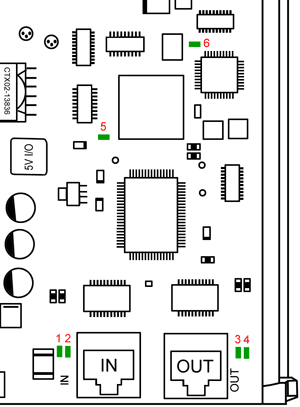This section covers the necessary requirements for connecting a SynqNet motion control system.
The cables used to connect SynqNet components depends on the types of connectors on each
piece of hardware.
The next step is to set up the hardware of the
system based upon the selected topology. Currently, SynqNet supports
the following three topologies:
More information about the various topologies can be found on the Node, Cable, Motor, Drive Addressing website.
Cable
Connections: Controller to Node(s)
The type of cables needed to connect the controller to the nodes will vary based upon the type of
controller, the particular hardware features, and the type of nodes being used in the SynqNet
Network. However, regardless of these variables, the cables are wired the same way. For
example, a cable from an OUT port will always connect into an IN port. The following diagram
clearly illustrates this connection pattern. For more information about cables and connectors, see the SynqNet Interface Cable website.
Types of Connectors and Cables
Depending on the type of SynqNet ports (RJ45 or Micro-D) on the Controller and Drive, use one
of the corresponding cables to connect them to each other.
See the Cables
section for a list of the various cables.
The following table lists some of the common
connectors and their matching cables.
|
Feature
|
Connector
|
Cable
|
| Controller I/O |
|
|
|
|
|
|
SynqNet
|
|
|
|
|
|
Power On Nodes and Check LEDs
After all of the nodes have been connected with
the proper cables, power-up the system. To verify that the Nodes
have been connected correctly and that each node is receiving
a network and power signal, inspect the LEDs at each connector.
Each controller will have four
LEDs:
Each node will have four green LEDs:
| |
Node LEDs on
the RMB-10V2-SynqNet
- LED1 - Link Activity
- LED2 - Node State
- LED3 - Link Activity
- LED4 - Repeater
- LED5 - FPGA
- LED6 - FPGA Boot Status
For more information, please see the Node LEDs section.
|

The RMB-10V2-SynqNet is shown above. |
